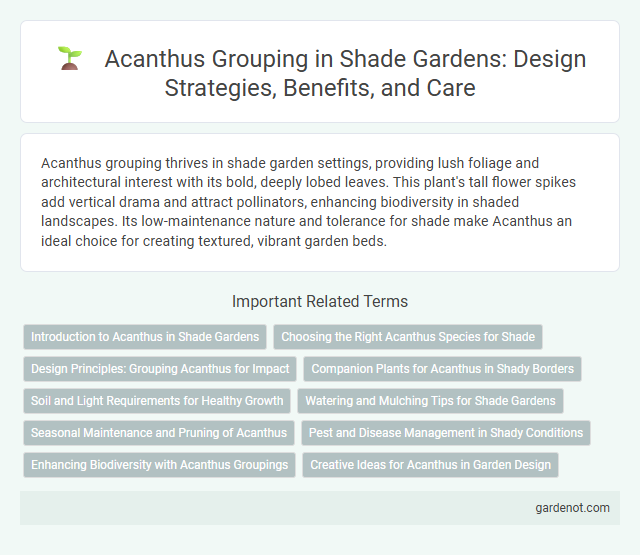Acanthus grouping thrives in shade garden settings, providing lush foliage and architectural interest with its bold, deeply lobed leaves. This plant's tall flower spikes add vertical drama and attract pollinators, enhancing biodiversity in shaded landscapes. Its low-maintenance nature and tolerance for shade make Acanthus an ideal choice for creating textured, vibrant garden beds.
Introduction to Acanthus in Shade Gardens
Acanthus plants thrive in shade gardens, providing lush, textured foliage that enhances low-light areas with minimal maintenance. Known for their architectural leaves and striking flower spikes, Acanthus species add visual interest and depth to shaded landscapes. Their adaptability to varying soil types and resistance to deer make them ideal for creating dynamic, shade-tolerant garden groupings.
Choosing the Right Acanthus Species for Shade
Choosing the right Acanthus species for shade involves selecting varieties that thrive in low-light conditions, such as Acanthus mollis and Acanthus spinosus, known for their large, glossy leaves and tolerance to partial shade. These species prefer well-drained soil with consistent moisture, making them ideal for shaded garden beds or under tree canopies. Incorporating shade-adapted Acanthus enhances foliage texture and creates a lush, vibrant understory in shaded garden environments.
Design Principles: Grouping Acanthus for Impact
Grouping Acanthus plants in shade gardens enhances visual interest through strategic spacing and layering, leveraging their bold, architectural foliage. Planting clusters of varying heights and textures creates depth and rhythm, maximizing the impact of their textured leaves and tall flower spikes. Incorporating Acanthus in repeated patterns or massed groupings establishes cohesion and draws attention to shaded garden beds.
Companion Plants for Acanthus in Shady Borders
Acanthus thrives in shady borders when paired with companion plants like ferns, hostas, and astilbes, which share similar moisture and light preferences. These shade-loving perennials enhance the textured foliage contrast and create layered visual interest while maintaining consistent soil moisture. Including evergreens such as boxwood or hellebores can provide year-round structure and complement Acanthus blossoms.
Soil and Light Requirements for Healthy Growth
Acanthus plants thrive in well-drained, fertile soil rich in organic matter, with a preference for consistently moist conditions to support robust growth. They perform best in partial to full shade, making them ideal for shaded garden areas where direct sunlight is limited but bright filtered light is available. Proper soil moisture and light exposure are crucial to prevent leaf scorch and promote lush foliage development.
Watering and Mulching Tips for Shade Gardens
Acanthus plants in shade gardens require consistent moisture, so watering deeply once or twice a week helps maintain healthy growth and vibrant foliage. Applying a 2-3 inch layer of organic mulch, such as shredded bark or compost, improves soil moisture retention and regulates temperature around the roots. Mulching also suppresses weed growth, which competes with Acanthus for nutrients and water in shaded environments.
Seasonal Maintenance and Pruning of Acanthus
Acanthus plants require seasonal maintenance that includes removing dead or damaged leaves in early spring to encourage new growth and maintain plant health. Pruning should focus on cutting back old flower stalks after blooming to promote a tidy appearance and prevent self-seeding. Dividing clumps every few years in fall or early spring helps rejuvenate the plants and supports vigorous growth in shade gardens.
Pest and Disease Management in Shady Conditions
Acanthus plants thrive in shade gardens but require vigilant pest and disease management to maintain healthy growth. Common pests like slugs and aphids can damage Acanthus foliage, necessitating regular inspection and organic control methods such as neem oil or handpicking. Shady, moist conditions may also promote fungal diseases like powdery mildew or root rot, which can be mitigated by ensuring proper air circulation and well-draining soil.
Enhancing Biodiversity with Acanthus Groupings
Acanthus groupings significantly enhance shade garden biodiversity by providing diverse habitat structures and attracting pollinators such as bees and butterflies. Their robust foliage and tall flower spikes create microenvironments that support beneficial insects and small wildlife, contributing to a balanced ecosystem. Integrating Acanthus species promotes soil health through organic matter accumulation and encourages natural pest control within shaded garden areas.
Creative Ideas for Acanthus in Garden Design
Acanthus thrives in shaded garden corners, offering bold, architectural foliage that enhances texture and depth in planting schemes. Grouping Acanthus with ferns, hostas, and astilbes creates layered contrasts, emphasizing their dramatic leaf structure while ensuring a lush, verdant atmosphere. Incorporate varying heights and complementary leaf shapes to achieve dynamic visual interest and natural flow in shade garden designs.
Acanthus grouping Infographic

 gardenot.com
gardenot.com